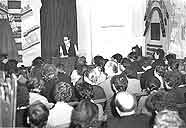Memoirs of Natalya Andreyevna Mayasova(page 2)
 After the war A.M. Kurbatova prepared a group of the Museum curators with secondary school education, but extraordinarily scrupulous and devoted to their work. The group included I.F. Kazakov, E.K. Rabinovich-Solntseva, N.N. Prasolova who came before the war. Some pre-war guides - S.S. Ragulina, T.A. Kruchkova - were still working. After the war an artist V.E. Karavai came to work as a guide. My task was to write methodical instructions for the tour of the architectural ensemble and all expositions. Those instructions were used for many years. In addition to the departments based on the Lavra collection, they began to form the department of Russian Folk Art before the war. Between 1940 and 1960 there worked an elder citizen of Zagorsk, an artist and enthusiast of Bogorodskoye carved toys T.K. Grushevskaya, L.N. Baikova, an art historian Z.S. Supishchikova. V. N. Dokuchayeva (an art historian) worked for about two years.
They organized the first big exhibition of folk art.
After the war A.M. Kurbatova prepared a group of the Museum curators with secondary school education, but extraordinarily scrupulous and devoted to their work. The group included I.F. Kazakov, E.K. Rabinovich-Solntseva, N.N. Prasolova who came before the war. Some pre-war guides - S.S. Ragulina, T.A. Kruchkova - were still working. After the war an artist V.E. Karavai came to work as a guide. My task was to write methodical instructions for the tour of the architectural ensemble and all expositions. Those instructions were used for many years. In addition to the departments based on the Lavra collection, they began to form the department of Russian Folk Art before the war. Between 1940 and 1960 there worked an elder citizen of Zagorsk, an artist and enthusiast of Bogorodskoye carved toys T.K. Grushevskaya, L.N. Baikova, an art historian Z.S. Supishchikova. V. N. Dokuchayeva (an art historian) worked for about two years.
They organized the first big exhibition of folk art.
In 1948 – 1949, the Commission of the USSR Ministry for Finances worked in the Museum. Its mission was to check the works of precious metals and stones. Being a post-graduate student, I worked for three days as a Museum representative in the Commission. So, I remember that hard time very well. The Museum and its Chief Curator, in particular, honorably passed the test, receiving no serious criticism from the Commission. At the same time an architect I.V. Trofimov helped to organize the first exhibition dedicated to history and restoration of the architectural ensemble. It was widely recognized, and its thematic and exhibition plan was admitted as my post-graduate theme. Later the exhibition was expanded and renovated by other specialists. A discouraging obstacle was frequent change of the Museum directors. V.K. Ryakhovsky was replaced by I.I. Belkin and I.I. Belkin was temporarily replaced by B.S. Shchipanov and then by Chigir. Deputy director Yu.A. Lebedeva, who started the Museum reconstruction, could not achieve understanding with I.I. Belkin, left for the Russian Museum in Leningrad in 1951. She was replaced by V.T. Kotov from the Palekh Museum. Between 1952 and 1962 I was to direct the scientific research. Those were the most memorable years of my life for we were young and full of energy, we loved the Museum and we were interested in our work. And, what was most important, we formed a strong, enthusiastic group, devoted to the Museum.
|


